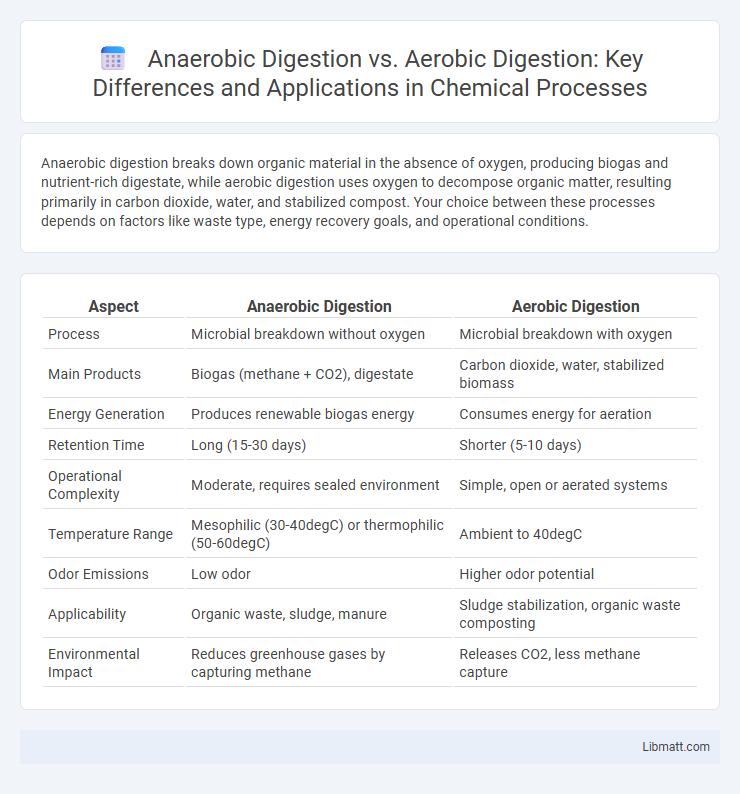Anaerobic digestion breaks down organic material in the absence of oxygen, producing biogas and nutrient-rich digestate, while aerobic digestion uses oxygen to decompose organic matter, resulting primarily in carbon dioxide, water, and stabilized compost. Your choice between these processes depends on factors like waste type, energy recovery goals, and operational conditions.
Table of Comparison
| Aspect | Anaerobic Digestion | Aerobic Digestion |
|---|---|---|
| Process | Microbial breakdown without oxygen | Microbial breakdown with oxygen |
| Main Products | Biogas (methane + CO2), digestate | Carbon dioxide, water, stabilized biomass |
| Energy Generation | Produces renewable biogas energy | Consumes energy for aeration |
| Retention Time | Long (15-30 days) | Shorter (5-10 days) |
| Operational Complexity | Moderate, requires sealed environment | Simple, open or aerated systems |
| Temperature Range | Mesophilic (30-40degC) or thermophilic (50-60degC) | Ambient to 40degC |
| Odor Emissions | Low odor | Higher odor potential |
| Applicability | Organic waste, sludge, manure | Sludge stabilization, organic waste composting |
| Environmental Impact | Reduces greenhouse gases by capturing methane | Releases CO2, less methane capture |
Introduction to Anaerobic and Aerobic Digestion
Anaerobic digestion is a biological process that breaks down organic material in the absence of oxygen, producing biogas primarily composed of methane and carbon dioxide, which can be used as a renewable energy source. Aerobic digestion involves the breakdown of organic matter by microorganisms in the presence of oxygen, resulting in carbon dioxide, water, and stabilized organic residue. Both processes are crucial for waste management, but anaerobic digestion generates energy-rich biogas while aerobic digestion is often used for composting and sludge stabilization.
Key Differences Between Anaerobic and Aerobic Digestion
Anaerobic digestion occurs in the absence of oxygen, breaking down organic material to produce biogas rich in methane, while aerobic digestion requires oxygen and results in carbon dioxide and water as byproducts. The anaerobic process is slower but generates renewable energy, making it ideal for waste-to-energy applications, whereas aerobic digestion is faster and commonly used for composting organic waste. Your choice between these methods depends on factors like energy recovery goals, waste type, and processing time.
Biological Processes in Anaerobic Digestion
Anaerobic digestion involves the breakdown of organic matter by microorganisms in the absence of oxygen, primarily through four stages: hydrolysis, acidogenesis, acetogenesis, and methanogenesis. This biological process converts complex organic compounds into biogas, consisting mainly of methane and carbon dioxide, while significantly reducing waste volume. In contrast, aerobic digestion relies on oxygen-dependent microbes to decompose organic material, resulting in faster stabilization but without biogas production.
Biological Mechanisms of Aerobic Digestion
Aerobic digestion relies on microorganisms that require oxygen to break down organic matter, producing carbon dioxide, water, and stabilized sludge. This process involves enzymatic activity where aerobic bacteria metabolize organic compounds through oxidative phosphorylation, yielding energy and biomass growth. The continuous oxygen supply accelerates decomposition rates, reduces odor, and minimizes the production of methane compared to anaerobic digestion.
Feedstock Suitability for Anaerobic vs Aerobic Digestion
Anaerobic digestion is highly effective for organic feedstocks rich in carbohydrates, fats, and proteins, such as agricultural waste, manure, and food scraps, due to its ability to break down complex molecules in oxygen-free environments. Aerobic digestion favors feedstocks with lower solids content and high moisture levels like wastewater sludge and biodegradable municipal waste, relying on oxygen to decompose organic matter efficiently. Feedstock suitability strongly influences process efficiency, with anaerobic digestion generating biogas and reducing odor, while aerobic digestion requires aeration and produces stabilized compost-like material.
Energy Production: Biogas vs Heat Release
Anaerobic digestion produces biogas, a renewable energy source composed primarily of methane and carbon dioxide, which can be captured and used for electricity, heating, or fuel. In contrast, aerobic digestion releases energy as heat through microbial oxidation, without generating usable fuel gas. Understanding these energy outputs helps you optimize waste treatment processes for sustainable energy recovery or thermal management.
Environmental Impacts and Emissions Comparison
Anaerobic digestion produces biogas, primarily methane, which can be captured and used as renewable energy, significantly reducing greenhouse gas emissions compared to aerobic digestion that releases CO2 directly. Aerobic digestion typically requires more energy input and emits higher levels of nitrous oxide, a potent greenhouse gas, contributing to a larger carbon footprint. Your choice between these methods impacts environmental sustainability, with anaerobic digestion offering superior benefits in minimizing emissions and generating clean energy.
Operational Costs and Infrastructure Requirements
Anaerobic digestion typically involves higher initial infrastructure costs due to the need for sealed reactors and gas management systems but benefits from lower operational expenses through energy recovery from biogas. Aerobic digestion requires less complex equipment but incurs higher ongoing costs related to aeration and energy consumption to maintain oxygen levels. Your choice between these methods should consider the balance between startup investment and long-term operational savings based on your specific waste management needs.
End Products and Their Applications
Anaerobic digestion produces biogas, primarily methane and carbon dioxide, which can be used as renewable energy for heating, electricity, or vehicle fuel, while the digestate serves as a nutrient-rich fertilizer. Aerobic digestion results in carbon dioxide, water, and stabilized biosolids that are commonly used as soil conditioners or compost to enhance soil health and structure. The choice between these processes depends on the desired end products and their specific applications in energy production or agricultural use.
Future Trends in Organic Waste Digestion Technologies
Anaerobic digestion is increasingly favored for organic waste management due to its ability to produce biogas, a renewable energy source, while aerobic digestion primarily focuses on rapid organic matter stabilization with higher energy input. Future trends emphasize integrating advanced microbial consortia and optimizing reactor designs to enhance biogas yields and reduce processing times in anaerobic systems. Innovations such as hybrid digestion systems and real-time monitoring technologies aim to improve the efficiency and sustainability of both anaerobic and aerobic organic waste digestion processes.
Anaerobic digestion vs aerobic digestion Infographic

 libmatt.com
libmatt.com